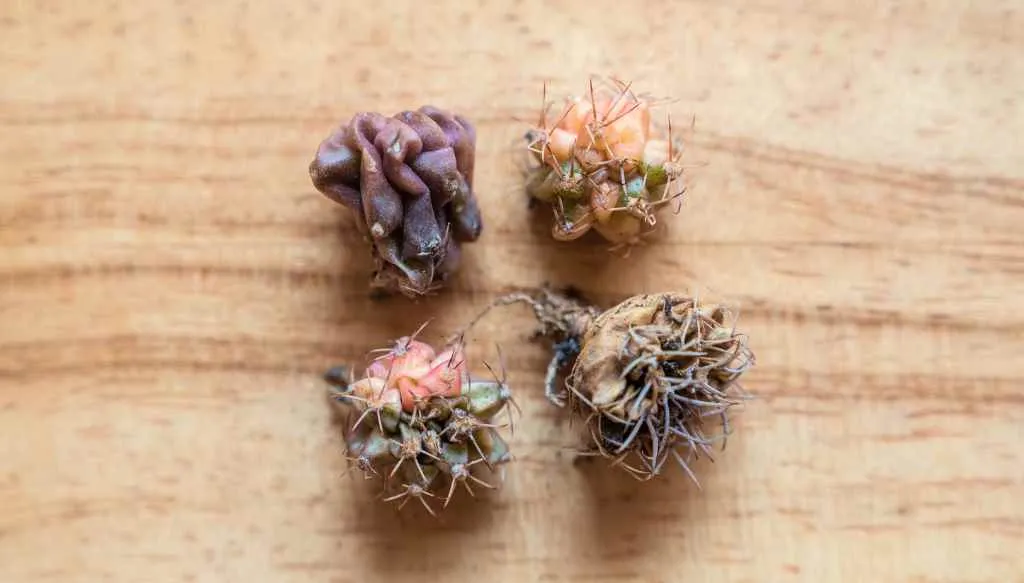Caring for cacti can sometimes be challenging, since it’s essential to decipher whether your cactus needs water or if it’s dying from heat stress. Watering your cacti at the wrong time can be deadly. This article will help you distinguish between the signs of a thirsty cactus and a cactus in distress due to excessive heat. By understanding these differences, you’ll be better equipped to provide the care your cactus needs.
This post contains affiliate links, which means I may receive a small commission if you make a purchase using these links. This commission comes at no additional cost to you.
Dig in!

Thirsty Cactus vs. Cactus Dying from Heat
Soil Moisture
- Thirsty Cactus: When a cactus is thirsty, the top inch of its soil will be dry to the touch. Insert your finger into the soil; if it feels completely dry, it’s time to water.
- Cactus Dying from Heat: A cactus dying from heat stress may have soil that is dry on the surface but still moist deeper down. The heat causes rapid evaporation from the soil’s surface, creating a misleading appearance of dryness.
Wrinkling and Shriveling
- Thirsty Cactus: When a cactus needs water, it may start to show signs of wrinkling or slight shrinkage. The skin might appear slightly puckered, indicating that it’s dehydrated.
- Cactus Dying from Heat: In contrast, a cactus exposed to excessive heat might also shrivel, but it will usually show signs of sunburn or browning as well. The skin can become discolored or damaged due to the intense sunlight.
Yellowing and Browning
- Thirsty Cactus: A cactus that requires water may exhibit mild yellowing of its lower pads or stems as a sign of stress. However, this is generally not as severe as the discoloration caused by heat.
- Cactus Dying from Heat: A cactus dying from heat stress will often display more severe and widespread yellowing or browning of its pads, stems, or spines. This is a clear indication that it’s struggling to cope with the high temperatures.
Wilting
- Thirsty Cactus: When a cactus is thirsty, it may begin to slightly droop or wilt. However, this wilting is usually minimal, and the cactus will regain its turgidity once it receives water.
- Cactus Dying from Heat: In contrast, a cactus exposed to excessive heat may wilt significantly, and the wilting is likely to be accompanied by other signs of heat stress, such as browning and damage to the plant.
Temperature Sensitivity
- Thirsty Cactus: A cactus that needs water is generally less sensitive to temperature fluctuations. It may still thrive in its preferred temperature range but won’t show severe stress solely due to temperature changes.
- Cactus Dying from Heat: A cactus dying from heat stress is highly sensitive to temperature extremes. It will show signs of distress, such as sunburn and wilting, when exposed to intense heat, even if it has sufficient moisture in its soil.
How to Prevent Your Cactus From Dying Due to Heat Stress
Choose the Right Location
The first step in preventing your cactus from dying from heat is selecting the right location. Place your cactus in an area where it receives bright, indirect sunlight. If you’re growing it indoors, make sure it’s near a window with filtered sunlight. Outdoor cacti should be positioned where they get some shade during the hottest parts of the day.
Use Adequate Soil
Proper soil is crucial for cactus health. Use a well-draining cactus mix that allows excess water to escape quickly. This prevents waterlogged soil, which can amplify the effects of heat stress on your cactus. Commercial cactus mixes are available, or you can create your own by adding sand or perlite to regular potting soil.
Water Wisely
Watering is a critical aspect of cactus care, especially during hot weather. Rather than sticking to a strict schedule, water your cactus when the top inch of soil feels dry to the touch. This prevents overwatering, which can compound heat-related stress. Remember that cacti are drought-tolerant plants, so it’s better to underwater than overwater.
Mulch the Soil
Adding a layer of mulch to the soil surface helps regulate temperature and moisture levels. Organic mulch, such as wood chips or gravel, can provide insulation and prevent the soil from heating up too quickly. Just be sure not to pile mulch against the cactus stem, as this can lead to rot.
Provide Shade
If you live in an area with scorching summer heat, consider providing some artificial shade for your outdoor cacti. You can use shade cloth or move them to a spot with natural shade during the hottest part of the day. Indoor cacti can benefit from sheer curtains or blinds that filter the sunlight.
Use Pots with Good Drainage
If you’re growing cacti in containers, choose pots with adequate drainage holes. Good ventilation is essential to prevent heat buildup in the soil. Additionally, avoid dark-colored containers that can absorb and radiate heat, opting for lighter shades instead.
Keep an Eye on Warning Signs
Finally, be vigilant and watch for signs of heat stress in your cactus. These can include wilting, yellowing, or browning of the cactus pads or stems. If you notice any of these symptoms, take immediate action by moving your cactus to a cooler location and adjusting your watering schedule.
Now that your familiar with the signs of heat stress and how to prevent it, get to know more about how to tell when your cactus needs water here: How to Tell If Your Cactus Needs Water: A Comprehensive Care Guide













